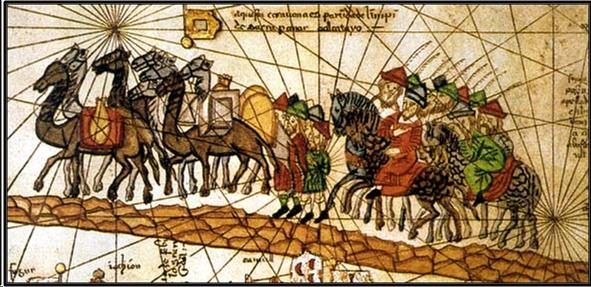

Medieval manuscript illustration -
Caravan traveling west on the Silk Road
The overall difficulty of travel and communication in the pre-modern world made it almost impossible for anyone to cross the Asian continent in an efficient way. Only a few individuals, most famously Marco Polo and his uncles, for example, actually traveled the length of the continent. Instead, merchants traveled in stages, as you can see in the map in the previous slide. Travel became easier under the great classical empires of Rome and Han China, as well as under the Kushan Kingdom, all of which created and maintained better roads and standardized coinage, allowing merchants not only easier travel but also easier financial transactions (thanks to having fewer currencies to deal with). Both of these advantages also reduced the costs of long-distance trade, making it more profitable and, therefore, more attractive. Still, the route remained segmented, as the difficulties presented by the geographical layout of the continent and dangers inherent in long-distance hauling made this arrangement the most sensible. Therefore, at its apex, the main route of the Silk Road started in the Han capital, Chang'an, and went west to the Taklamakan Desert. There the road split into two main branches that skirted the desert to the north and south. Once around the desert, the road branched off in many directions, including southern routes to India, southwestern routes to Egypt, and western routes to Antioch in the Levant. / As you can imagine, the length and segmentation of the Silk Road required the involvement of individuals from all of the many territories through which these trade routes cut. Many people thus benefitted from the goods made available and the wealth to be made through the Silk Road. Still, it was the major commercial powers - including the Chinese, Parthians, Persians, Indians, and Romans - who ultimately profited most from long-distance trade along the Silk Road, as they could set the terms of exchange, charge a variety of tariffs and taxes, and control the flow of goods through their territories. / As a final note about the organization of the Silk Road, I would like to talk about two important innovations developed specifically to deal with the difficulties presented by travel along the Silk Road. The first is the development of caravans, companies of travelers who banded together, offering mutual assistance and defense when travelling through dangerous territory. These caravans would hire their own guide or local guides, as well as soldiers to offer protection against bandits and marauders, against which not even the most powerful empires had developed systematic defenses. Perhaps the most important element of the caravans were their camels, which represent the second innovation which Silk Road travelers embraced. Sturdy animals acclimated to the desert, camels can go long distances without water and have broad hoofs which allow them to carry heavy loads across the soft sand surface of the desert. Therefore, they are the perfect vehicle for hauling both goods and people along the long stretches of desert between settled trading posts.